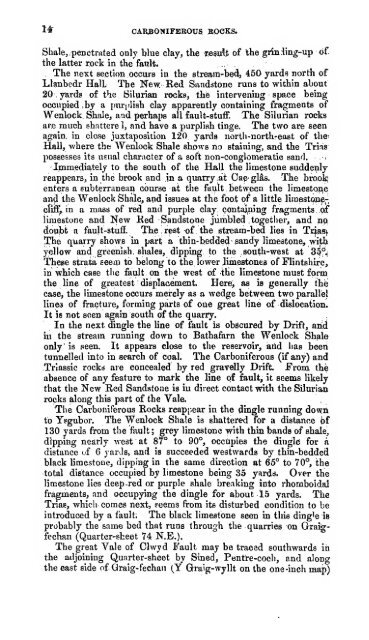The geology of the neighbourhoods of Flint, Mold, and Ruthin ...
The geology of the neighbourhoods of Flint, Mold, and Ruthin ...
The geology of the neighbourhoods of Flint, Mold, and Ruthin ...
You also want an ePaper? Increase the reach of your titles
YUMPU automatically turns print PDFs into web optimized ePapers that Google loves.
1* CARBONIFEROUS BOCKS.<br />
Shale, .-penetrated only blue clay, <strong>the</strong> result <strong>of</strong> <strong>the</strong> grin;ling-up <strong>of</strong><br />
<strong>the</strong> latter rock in <strong>the</strong> fault.<br />
. <strong>The</strong> next section occurs in <strong>the</strong> stre»n>bed, 450 yards north <strong>of</strong><br />
Llanbedr Hall. <strong>The</strong> New: Red S<strong>and</strong>stone runs to within about<br />
yards <strong>of</strong> <strong>the</strong> Silurian rocks, <strong>the</strong> intervening space being<br />
20 .<br />
occupied, by a purplish clay apparently containing fragments <strong>of</strong><br />
Wenlock Shale, <strong>and</strong> perhaps all fault-stuff. <strong>The</strong> Silurian rocks<br />
are much shattere 1, <strong>and</strong> have a purplish tinge. <strong>The</strong> two are seen<br />
again, in close juxtaposition 120 yards north -northreast <strong>of</strong> <strong>the</strong>-<br />
Hall, where <strong>the</strong> Wenlock Shale shows no staining, <strong>and</strong> <strong>the</strong> Trias<br />
possesses its usual character <strong>of</strong> a s<strong>of</strong>t non-conglomeratic s<strong>and</strong>. .-i.<br />
Immediately to <strong>the</strong> south <strong>of</strong> <strong>the</strong> Hall <strong>the</strong> limestone suddenly<br />
reappears, in <strong>the</strong> brook <strong>and</strong> in a quarry at Oae-glas. <strong>The</strong> brook;<br />
enters a subterranean course at <strong>the</strong> fault between <strong>the</strong> limestone<br />
ancl <strong>the</strong> Wenlock Shale, <strong>and</strong> issues at <strong>the</strong> foot <strong>of</strong> a little limestonecfift,<br />
in a mass <strong>of</strong> red <strong>and</strong> purple clay containing fragments , <strong>of</strong><br />
limestone <strong>and</strong> New Red S<strong>and</strong>stone jumbled toge<strong>the</strong>r, <strong>and</strong> np.<br />
doubt a fauh-stuff. <strong>The</strong> rest <strong>of</strong> <strong>the</strong> stream-bed lies in Triasi<br />
<strong>The</strong> quarry shows in part a thin-beddecl- s<strong>and</strong>y limestone, with<br />
yellow <strong>and</strong> greenish, shales, dipping to <strong>the</strong> south-west at 3p°^<br />
<strong>The</strong>se strata seem to belong to <strong>the</strong> lower limestones <strong>of</strong> <strong>Flint</strong>shire,<br />
in which case <strong>the</strong> fault on <strong>the</strong> west <strong>of</strong> <strong>the</strong> limestone must form<br />
<strong>the</strong> line <strong>of</strong> greatest ' displacement. Here, as is generally <strong>the</strong><br />
case, <strong>the</strong> limestone occurs merely as a wedge between two parallel<br />
lines <strong>of</strong> fracture, forming parts <strong>of</strong> one great line <strong>of</strong> dislocation.<br />
It is not seen again south <strong>of</strong> <strong>the</strong> quarry.<br />
In <strong>the</strong> next dingle <strong>the</strong> line <strong>of</strong> fault is obscured by Drift, <strong>and</strong><br />
in <strong>the</strong> stream running down to Bathafarn <strong>the</strong> Wenlock Shale<br />
only' is seen. It appears close to <strong>the</strong> reservoir, <strong>and</strong> lias been<br />
tunnelled into in search <strong>of</strong> coal. <strong>The</strong> Carboniferous (if any) <strong>and</strong><br />
Triassic rocks are concealed by red gravelly Drift. From <strong>the</strong><br />
absence <strong>of</strong> any feature to mark <strong>the</strong> line <strong>of</strong> fault, it seems likely<br />
that <strong>the</strong> New Ked S<strong>and</strong>stone is in direct contact with <strong>the</strong> Silurian<br />
rocks along this part <strong>of</strong> <strong>the</strong> Vale.<br />
<strong>The</strong> Carboniferous Rocks reappear in <strong>the</strong> dingle running down<br />
to Ysgubor. <strong>The</strong> Wenlock Shale is shattered for a distance <strong>of</strong><br />
grey limestone with thin b<strong>and</strong>s <strong>of</strong> shale^<br />
130 yards from <strong>the</strong> fault ;<br />
dipping nearly west at 87° to 90°, occupies <strong>the</strong> dingle for a<br />
distance <strong>of</strong> 6 yarJs, <strong>and</strong> is succeeded westwards by thin-bedded<br />
black limestone, dipping in <strong>the</strong> same direction at 65° to 70°, <strong>the</strong><br />
total distance occupied by limestone being 35 yards. Over <strong>the</strong><br />
limestone lies deep-red or purple shale breaking into rhornboidal<br />
fragments, <strong>and</strong> occupying <strong>the</strong> dingle for about 15 yards. <strong>The</strong><br />
Trias, which comes next, eeems from its disturbed condition to be<br />
introduced by a fault; <strong>The</strong> black limestone seen in this ding'e is<br />
probably <strong>the</strong> same bed that runs through <strong>the</strong><br />
fechan (Quarter-sheet 74 N.E.).<br />
quarries on Graig-<br />
<strong>The</strong> great Vale <strong>of</strong> Clwyd Fault may be traced southwards in<br />
<strong>the</strong> adjoining Quarter-sheet by Sined, Pentre-coch, <strong>and</strong> along<br />
<strong>the</strong> east side <strong>of</strong> Graig-feehan (Y Graig-wyllt on <strong>the</strong> one-inch map)



